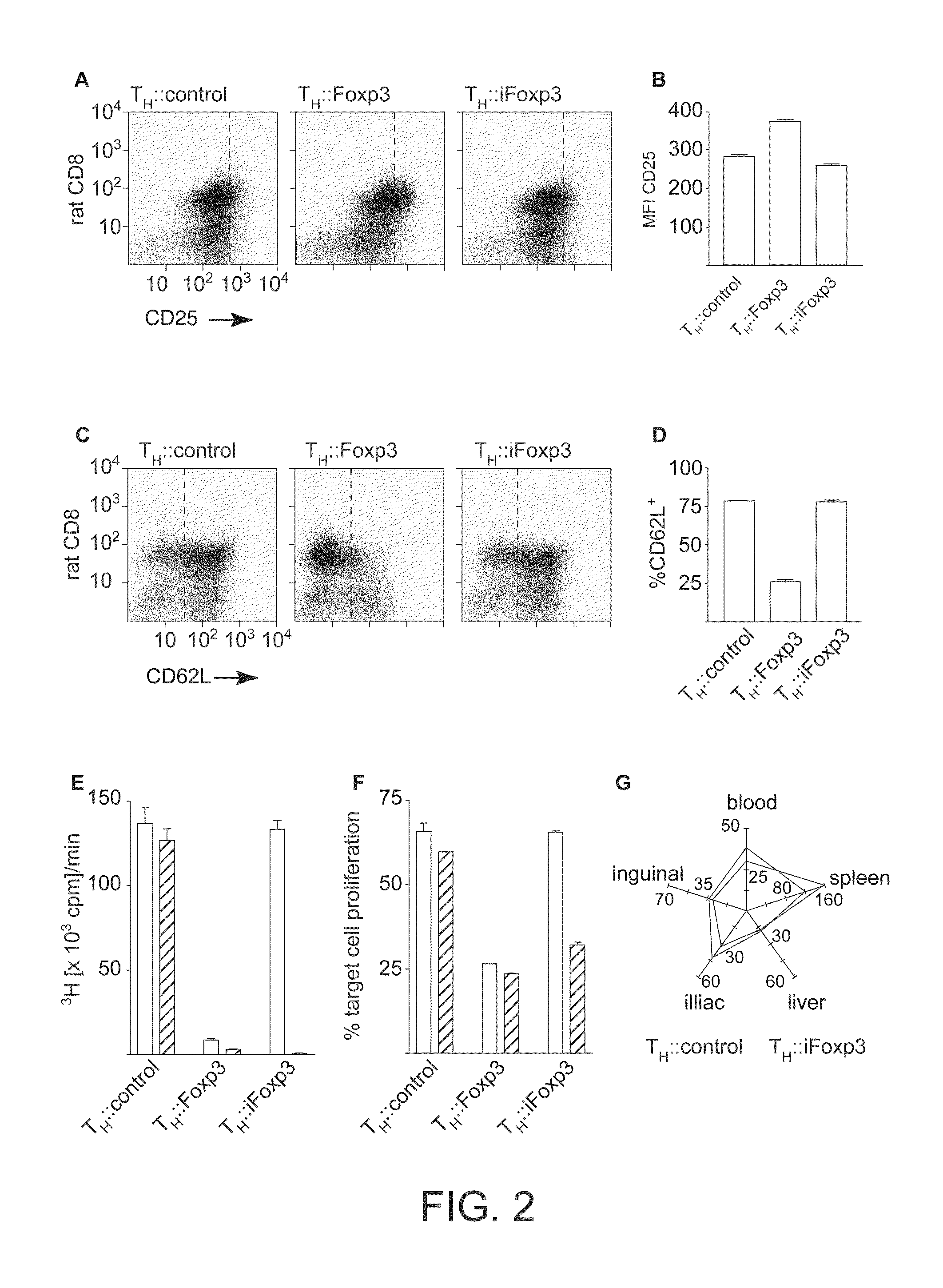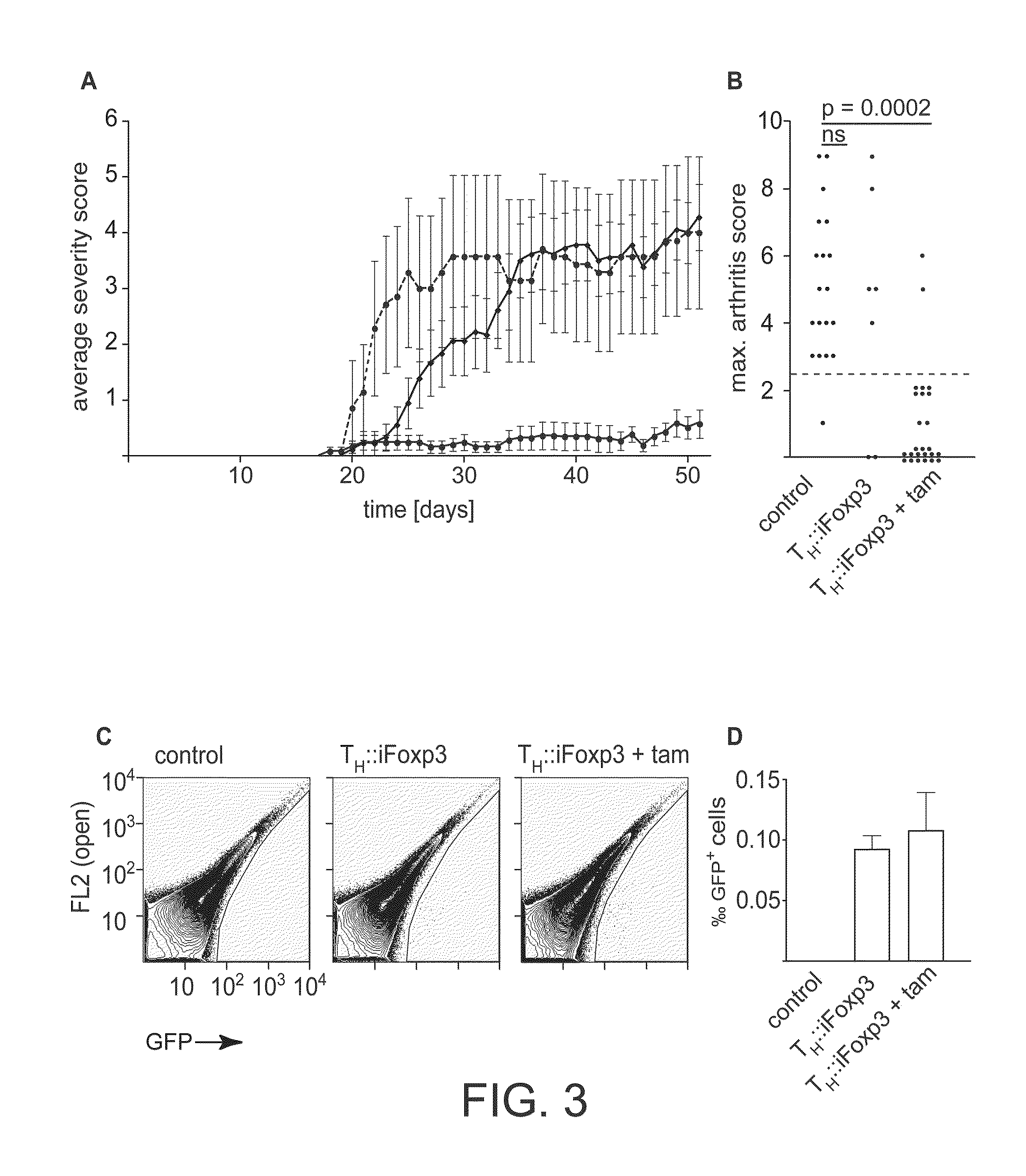Methods of switching the phenotype of t cells by transgenic lineage factor foxp3
a transgenic lineage factor and cell type technology, applied in foreign genetic material cells, biochemistry apparatus and processes, blood/immune system cells, etc., can solve the problems of unstable induction of foxp3 and inconvenient homing behavior, and achieve the effect of reducing the need for continuous induction treatment and inappropriate homing behavior
- Summary
- Abstract
- Description
- Claims
- Application Information
AI Technical Summary
Benefits of technology
Problems solved by technology
Method used
Image
Examples
example 1
Cell Homing Behaviour
Background
[0159]The efficacy of the use of naïve, polyclonal wild type TH::Foxp3 cells to treat autoimmune disease has been very limited7,12. Indeed, our own attempts to treat collagen-induced arthritis with TH::Foxp3 cells, i.e. cells constitutively expressing Foxp3 according to the prior art, failed entirely (FIGS. 1a and b). This might be due to the low frequency of antigen specific cells within the transferred population11. The low number of antigen-specific TH::Foxp3 cells in a polyclonal pool of cells might be overwhelmed by the high number of already expanded pro-inflammatory T cells. However, as we have demonstrated that antigen experienced regulatory T cells are effective suppressors at extremely low ratios13, we found this to be an inadequate explanation.
Homing Behaviour
[0160]According to the insight of the inventors, it was suspected that the process of generating TH::Foxp3 cells altered their homing behaviour. Indeed, we find that most of the TH::Fox...
example 2
Inducible Lineage Factors
[0162]Next we demonstrate a strategy that utilizes an inducible lineage factor. We demonstrate a method of switching the phenotype of a target cell, which method comprises inducing lineage, factor activity in the target cell via a transgene. In this example the lineage factor is Foxp3 (inducible Foxp3=“iFoxp3”), and the transgene encodes Foxp3 polypeptide having lineage factor activity. In this example the transgene is introduced into the target cell using a retroviral vector.
[0163]According to the invention cells transduced with a retroviral transgene expressing iFoxp3 (TH::iFoxp3 cells) should retain the phenotype of pro-inflammatory T cells. When encountering an antigen they should participate in the immune response, expand and exert their pro-inflammatory functions until Foxp3 is induced. Upon induction, the transduced cells should assume the phenotype of regulatory T cells and suppress the response they are involved in. This approach has the advantage t...
example 3
Expansion and Switching of Target Cells Using Inducible Lineage Factors
[0168]To assess whether TH::Foxp3 and TH::iFoxp3 cells expand upon antigenic challenge in vivo, we transferred Foxp3− or iFoxp3-transduced T cells from DO11.10xSCID mice, expressing an ovalbumin-specific T cell receptor transgene, into wild type Balb / c mice. In order to approximate physiological conditions whilst still retaining a measurable effect, we transferred only 2×104 cells transduced cells (19). We found that TH::iFoxp3 cells expanded upon immunization with ovalbumin (ova) by a factor of 12 in the draining lymph nodes and a factor of 37.5 in the spleen. In contrast, TH::Foxp3 cells only exhibited a very modest expansion by a factor of 3.6 in the lymph nodes and 4.4 in the spleen (FIG. 9A). This could have been due to the TH::Foxp3 cells limiting the response and thereby impeding their own expansion. However, when we examined the levels of ova specific antibodies in the serum, we found no difference betwee...
PUM
| Property | Measurement | Unit |
|---|---|---|
| Concentration | aaaaa | aaaaa |
| Fluorescence | aaaaa | aaaaa |
Abstract
Description
Claims
Application Information
 Login to View More
Login to View More - R&D
- Intellectual Property
- Life Sciences
- Materials
- Tech Scout
- Unparalleled Data Quality
- Higher Quality Content
- 60% Fewer Hallucinations
Browse by: Latest US Patents, China's latest patents, Technical Efficacy Thesaurus, Application Domain, Technology Topic, Popular Technical Reports.
© 2025 PatSnap. All rights reserved.Legal|Privacy policy|Modern Slavery Act Transparency Statement|Sitemap|About US| Contact US: help@patsnap.com



